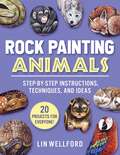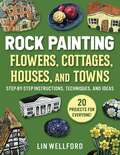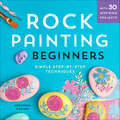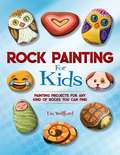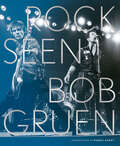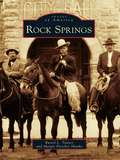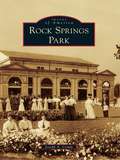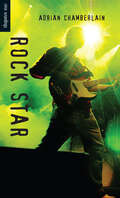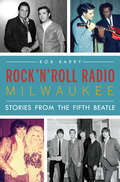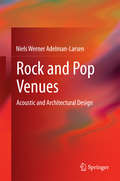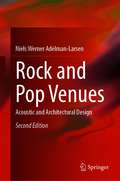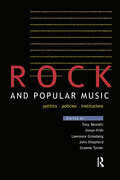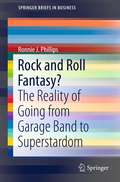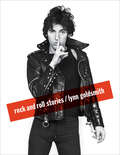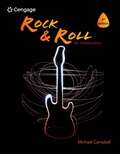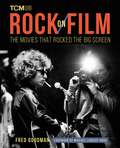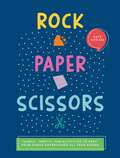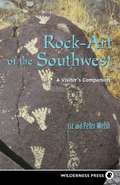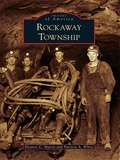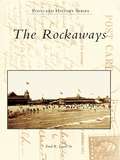- Table View
- List View
Rock Painting Animals: Step-by-Step Instructions, Techniques, and Ideas—20 Projects for Everyone!
by Lin WellfordPerfect for kids, crafters, and animal lovers, this fun guide will teach you how to paint your favorite wild animals and family pets on stones! New painters wanted! No experience necessary! With Lin Wellford&’s instruction, thousands have discovered the thrill of turning rocks into works of art. Her bestselling books have helped to awaken interest in modern rock painting. It's the perfect hobby—fast, fun, and inexpensive.Rock Painting Animals offers a variety of easy projects designed to introduce basic painting techniques yet still appeal to seasoned painters. Learn to paint your favorite animals, including:CatsKittensDogsDeerFishFoxesGuinea PigsLadybugsOwlsParrotsRabbitsRaccoonsSnakesTurtlesWith tips on how to translate an animal's features into simple geometric shapes that maintain proper proportion and perspective, these projects will have you purring with delight. Grab a brush, find a stone, and get ready to rock! Experience the magic of this fun and exciting art activity.
Rock Painting Flowers, Cottages, Houses, and Towns: Step-by-Step Instructions, Techniques, and Ideas—20 Projects for Everyone
by Lin WellfordPerfect for kids and crafters, this fun guide will teach you how to paint flowers, cottages, houses, and towns on stones! New painters wanted! No experience necessary! With Lin Wellford&’s instruction, thousands have discovered the thrill of turning rocks into works of art. Her bestselling books have helped to awaken interest in modern rock painting. It's the perfect hobby—fast, fun, and inexpensive.Rock Painting Flowers, Cottages, Houses, and Towns offers a variety of easy projects designed to introduce basic painting techniques yet still appeal to seasoned painters. Learn to paint your favorite scenery elements, including:DaisiesTulipsPetuniasDaffodilsPansiesMumsWreaths of RosesFlower BasketsCottagesA-FramesChaletsGnome HomesBarnsCountry ChurchSmall Town ShopsFarmhousesProduce MarketsColonial Style BuildingsTudor-Style HomesVictorian MansionsRock VillagesWith tips on how to translate an animal's features into simple geometric shapes that maintain proper proportion and perspective, these projects will brighten any home or garden. Grab a brush, find a stone, and get ready to rock! Experience the magic of this fun and exciting art activity.
Rock Painting for Beginners: Simple Step-by-Step Techniques
by Adrianne SurianLearn how easy it is to create colorful painted rocks with Rock Painting for BeginnersIf you've ever wanted to dabble in rock painting, this is the perfect book for you. This guide for beginners will teach you how to feel confident with a paintbrush with step-by-step art projects. Learn how to create beauty in your life with a craft that's easy to do.Learn how to use the tools and paints needed, and what kinds of rocks to seek out.From tape-resistant painting to hand lettering to stencils and stamps, start your journey in rock painting with art projects designed to refine specific techniques.Get inspired with ideas to engage with your community and spread joy with small painted rocks around your neighborhood, your city, and beyond.Cultivate your creativity with this fun, encouraging rock painting book for beginners.
Rock Painting for Kids: Painting Projects for Rocks of Any Kind You Can Find
by Lin WellfordAre you ready to rock? With this book, you can create amazing creatures, incredible toys, and wild gifts for your friends and family. All it takes is some paint, a few rocks, and your imagination! Easy-to-follow instructions from rock painting expert Lin Wellford will teach you how to create: Rockasaurs Stone buildings Rockburgers and other fun foods Flowers Teddy bears And other awesome rock projects perfect for decorating any space! Also included are tips and tricks to make your rocks into masterpieces! You’ll learn how to draw each design on a rock with a pencil, then paint the details in whatever colors you choose. You can make each project look just like the real thing or as wild and wacky as you prefer. The choice is yours—and so is the fun!
Rock Seen
by Bob Gruen&“The official monograph of rock and roll&’smost famous photographer, Rock Seen is a must-have for all rock fans.&” (RollingStone.com) For forty years, Bob Gruen&’s name has been synonymous with rock and roll. From taking early photos on tour with Ike and Tina Turner, to capturing the early CBGB/Max&’s Kansas City scene to covering current stadium rockers such as Green Day, Gruen has always been at the right place at the right time—and he&’s always gotten the shot. In this lavish monograph, Gruen has curated his favorite photographs from his career, with intimate captions and behind-the-scenes anecdotes. Featuring such illustrious acts as the Clash, Led Zeppelin, the Rolling Stones, Sex Pistols, Ramones, and more, and including an introduction by the legendary Debbie Harry of Blondie, this collection is a must-have for all fans of rock and roll. &“Rock Seen offers a disarmingly natural look at icons like Blondie and Cher before the era of the posed rock-star portrait kicked in.&” —Entertainment Weekly &“Rock Seen . . . hits the high points on and off the stage in rock&’s past four decades.&” —USA Today &“Go backstage with forty years&’ worth of rock-and-roll images from the legendary lens of Bob Gruen. . . . From over-the-top action shots of Elton John&’s acrobatics to private pics of Lennon and Yoko in bed with baby Sean to boozy plane rides with the Sex Pistols, the glossy pages act as your VIP pass to the rock-star lifestyle you&’ve dreamed of.&” —Marie Claire &“Gruen had a front-row seat to the rise of many rock legends [from] Elton John to Green Day.&” —The New York Post
Rock Springs
by Margie Fletcher Shanks Russel L. TannerAn ancient inland sea, surrounded by lush vegetation and inhabited by dinosaurs, helped create the mineral-rich landscape where Rock Springs, Wyoming, now sits. French trappers first encountered American Indians who were traveling via a natural corridor that traverses the region, and eventually pioneer trails used this same route in the great westward expansion. The First Transcontinental Railroad arrived in 1868, and the national demand for energy in the form of fossil fuels turned everyone's attention to the vast coal deposits. Thus the frontier outpost of Rock Springs became an important energy center, and immigrants from around the world came to work in the mines and make this land their home. As local businessman Leonard Hay used to say, "All wealth comes from the earth." Today other minerals have joined coal as new sources of wealth for Rock Springs, and plans are being made to harness the wind that carved out this unique landscape.
Rock Springs Park (Images of America)
by Joseph A. CommOnce described as "a place where God and man went fifty-fifty to produce perfection," Rock Springs Park remained a landmark along the Lincoln Highway in Chester until 1970. In its heyday, this panhandle playground captivated 20,000 visitors daily with attractions including the World's Greatest Scenic Railway, the Cyclone Roller Coaster, and a hand-carved 1927 Dentzel Carousel. Images of America: Rock Springs Park features over 200 rarely seen images and portrays the lifespan of the park from its history as Native American hunting grounds to its development as a local trolley park and full-fledged amusement park. The park hosted business and community picnic excursions and countless celebrity entertainers. Performer Bobby Vinton remembers the era of dances at the park as "a very romantic time . . . almost like something in the movies. There was the carousel, the guys in white shoes and girls that were all dressed up with their crinoline skirts."
Rock Star (Orca Soundings)
by Adrian ChamberlainStruggling at home and at school, Duncan decides to try out for a local rock band. He plays the bass in the school orchestra, but it is a long way from band camp to rock star. Joining a heavy-metal band, he tries to fit in, dumping his old friends and trying to walk the walk. When his dad's new girlfriend starts to teach him about real rock music and introduces him to her musician brother, Duncan discovers that there is more to being a guitar hero than playing in a heavy-metal band.
Rock Your Rental: Style, Design, And Marketing Tips To Boost Your Bookings
by Joanne Palmisano Rosanne PalmisanoA fun how-to guide to help vacation rental owners create big designs on small budgets By 2020, vacation rentals are expected to surpass the hotel industry. But with so much competition, how do property owners stand out? In Rock Your Rental, the Palmisano sisters offer their unique design ideas to upgrade your space from sometimes-booked to a sought-after lodging destination. Full of inspiration, DIY projects, marketing tips, and gorgeous before-and-after photos, this book is essential reading for innkeepers, bed-and-breakfast owners, and hotel hosts—and especially for vacation rental owners who use sites such as Airbnb, VRBO, HomeAway, and Booking.com. A witty, go-to handbook with actionable tips, examples, and ideas, Rock Your Rental is an essential resource for property owners who want to increase their bookings, profits, and the happiness of their customers.
Rock `n´ Roll Radio Milwaukee: Stories from the Fifth Beatle
by Bob BarryBob Barry ruled Milwaukee's airwaves in the '60s and '70s. The only time the Beatles performed here, Barry introduced them to the audience, and he was the only local personality who spent time in private with the Fab Four. If a band or musician came to town, he met them with a microphone. Chuck Berry, the Animals, Wings, the Rolling Stones--the list goes on. His popular "Bob Barry Calls the World" segment entertained thousands with cold calls to famous personalities, including Bob Hope, Sophia Loren, Elton John and Cher. Through it all, Barry maintained a calm and fun-loving demeanor, even when mocked by the WOKY Chicken or nearly eaten by wolves on the air. Packed with never-before-seen photos, this revealing memoir recalls the iconic DJ's many celebrity encounters, his career highlights and setbacks and the hijinks that made Milwaukee radio rock.
Rock and Pop Venues
by Niels Werner Adelman-LarsenPopular music plays a substantial role in most people's life. The demand and financial revenue of Rock and Pop concerts is large and still increasing with the decreased revenue on recorded music. Based on the first ever scientific investigations on recommendable acoustics for amplified music conducted by the author, this book sets forward precise guidelines for acoustical engineers to optimize the acoustics in existing or future halls for amplified music. Gives precise guidelines on how to design the acoustics in venues that present amplified music Debates essential construction details, including placement of sound system and use of possible building materials, in the architectural design of new venues or the renovation of old ones Portrays 75 well-known European Rock & Pop venues, their architecture and acoustic properties. 20 venues were rated for their acoustics by music professionals leading to an easy-to-use assessment methodology "Acoustics are important within pop and rock venues to ensure a great experience for audiences and performers. This book fills an important gap of knowledge on the acoustics of venues. It will be of value to sound engineers as well as building owners and operators and building design professionals". Rob Harris, Arup Acoustics "With this book, many future amplified music concerts will sound better, for the joy of audiences and musicians alike. This enormous work demonstrates a rare degree of passion and insight, from the hand of the key researcher in the field". Dr. Per V. Brüel
Rock and Pop Venues: Acoustic and Architectural Design
by Niels Werner Adelman-LarsenThis new edition of this standard work adds several new information the book, so that sound engineering and architects can better assess the acoustic value of a Rock and Pop Venue. In particular, new insights to the influence of sound absorbers in reflected and important ISO standards are included into the new edition. Based on the first ever scientific investigations on recommendable acoustics for amplified music conducted by the author, this book sets forward precise guidelines for acoustical engineers to optimize the acoustics in existing or future halls for amplified music. It Gives precise guidelines on how to design the acoustics in venues that present amplified music Debates essential construction details, including placement of sound system and use of possible building materials, in the architectural design of new venues or the renovation of old ones Portrays 75 well-known European Rock & Pop venues, their architecture and acoustic properties. 20 venues were rated for their acoustics by music professionals leading to an easy-to-use assessment methodology
Rock and Popular Music: Politics, Policies, Institutions (Culture: Policy and Politics)
by Tony Bennett Simon Frith Graeme Turner John Shepherd Larry GrossbergRock and Popular Music examines the relations between the policies and institutions which regulate contemporary popular music and the political debates, contradictions and struggles in which those musics are involved.International in its scope and conception, this innovative collection explores the reasons for and ways in which governments have sought either to support or prohibit popular music in Canada, Australia and Europe as well as the impact of broadcasting policies in forming and shaping different musical communities.Rock and Popular Music is a unique collection suggesting significant new directions for the study of contemporary popular musics.
Rock and Role (Cinderella Cleaners)
by Maya GoldDiana has always dreamed of being an actress or celebrity--and now, for the first time, opportunity has come knocking. When Tasha Kane, a pop star who is even bigger than Taylor Swift, comes to film her latest video in Diana's hometown, Diana gets a chance to audition. The only problem is, her role in the video hinges on wearing her rockin' vest--which she just happened to borrow from Cinderella Cleaners! Diana has to return the vest, but does that mean she can't be in the coolest video of all time?
Rock and Roll Fantasy?
by Ronnie PhillipsWe are in an era where developments in both technology and musical style have coalesced to produce the greatest period of change in the music industry since the invention of recorded sound. Globalization, the Internet, and digital technology are now opening up possibilities for more artists to be innovative and financially successful. But new music requires new ways of doing business. For more artists to be better off requires new business models to replace those that dominated the 20th century. Integrating insights from economics, management, and intellectual property law, the author explores the dynamics of entrepreneurship and innovation in the music industry, and offers such provocative assessments as these: · The Beatles might never have broken up if they had the kind of two-tier contracts - as band members and as solo artists - that are common in the music industry today. · Buddy Holly would likely have avoided his tragic death in a plane crash at age 22 if his 1959 tour had been sponsored by a company like Coca Cola because today's corporatized tours are vastly better financed and organized than the haphazard efforts of the 1950s. · The economic value of albums by the likes of Elvis and Michael Jackson has risen significantly since their deaths - the ironic byproduct of the way their behavior tarnished their own brands while they were alive. · Diana Ross might never have quit The Supremes if she had known that one-third of the artists in the 1960s who quit the group had charting careers of only one year. · Thomas Edison's invention of the phonograph led to the modern record industry, but he is really the godfather of computer programs like Garageband which have created home recording studios. The collapse of the Soviet Union threatened the sound of rock and roll but an American entrepreneur saved the day.
Rock and Roll Stories
by Lynn GoldsmithThe story of rock lives in Lynn Goldsmith’s photographs. After coming of age in the Midwest in the tumultuous 1960s, she crashed the music scene in New York and emerged as one of its leading image-makers. She chronicled Bruce Springsteen’s passage to glory, the Rolling Stones’ legendary stadium tours, Michael Jackson’s staggering ascent, U2’s arrival in New York, and the brooding force of Bob Marley. Culture heroes like Bob Dylan and Patti Smith became frequent subjects for her lens. The range of her work is staggering. In Rock and Roll Stories, she shares the best of this work. Her commentary takes the reader into the studio, the tour bus, the concert hall, and the streets where the pictures were made, offering revealing perspectives on her subjects and herself. A greatly expanded and newly designed edition of her very successful book PhotoDiary (1995), this volume captures the story of a generation’s loyalty to rock and roll.
Rock and Roll: An Introduction
by Michael CampbellThis 3rd Edition has been completely reconceived and rewritten, to take advantage of online delivery of recorded music. The discussion in this edition is even more focused on rock as music and stresses perceptive listening. This in turn permits more extensive discussion of stylistic connections and contrasts and ways in which the music reflects and shapes society and culture. An extensive and representative play list of 115 rock-era songs is discussed.
Rock in Fashion
by John VarvatosIn John Varvatos, the legendary designer reveals his perspective on how rock & roll music and style have influenced his own designs and fashion worldwide. Varvatos’s personally curated collection of more than 250 images are some of the most provocative ever shot by top rock photographers from the late 1960s to today, from the Rolling Stones to the Kings of Leon. The featured photographers are among the world’s finest, including Mick Rock, Bob Gruen, Elliott Landy, Danny Clinch, Lynn Goldsmith, and more. Also included are select images from Varvatos’s own advertising campaigns, featuring artists such as Slash, Iggy Pop, Scott Weiland, and Miles Kane. Varvatos’s captions and incisive commentary on the artist and his or her look accompany each image. Every chapter also contains numerous quotes from the musicians themselves, including Mick Jagger, Keith Richards, Iggy Pop, Jack White, Pete Townshend, Robert Plant, Steven Tyler, and Patti Smith. An extraordinary anthology of some of the finest images in rock & roll and the most influential rock looks in fashion and popular culture, this volume will delete music lovers, and fans of music photography, fashion, and fashion history
Rock on Film: The Movies That Rocked the Big Screen (Turner Classic Movies)
by Fred GoodmanFor rock music and film buffs alike, this is the ultimate guide exploring the electrifying, entertaining, and often daring marriage of rock & roll and cinema.When the use of Bill Haley&’s &“Rock Around the Clock&” turned 1955&’s Blackboard Jungle into a teen sensation and a box-office smash, it proved the opening shot in a cinematic and cultural revolution. Starting with Elvis Presley and the teensploitation films of the &’50s and &’60s, in Rock on Film award-winning author and former Rolling Stone editor Fred Goodman takes readers on a wide-ranging journey through film and pop history. Along the way, he measures the transformative impact of the mid-&’60s landmarks A Hard Day&’s Night and Dont Look Back and how they seeded an almost unbelievably broad genre of films made by increasingly ambitious musicians and filmmakers across the past seven decades.From the carefree to the complex, the mindless to the mind-bending, rock films have staked out their own turf by simultaneously celebrating innocence and challenging artistic and social conventions. With an insightful round-up of fifty must-see rock films spanning crowd-pleasers, art-house favorites, underground gems, and undisputed classics, Rock on Film surveys the nearly seventy-year canon of a genre like no other.A series of original interviews with Cameron Crowe, Jim Jarmusch, Penelope Spheeris, Taylor Hackford, and John Waters illuminates how rock has influenced the work of some of the most divergent and thoughtful directors in movie history. Illustrated throughout by more than 150 full-color and black-and-white images, Rock on Film brings the history of music in the movies to vivid life.
Rock, Paper, Scissors: Simple, Thrifty, Fun Activities to Keep Your Family Entertained All Year Round
by Kate HodgesRock, Paper, Scissors is a collection of creative, fun, sense-stimulating things you can do with very simple materials: stones, paper and scissors.From land art to science experiments, with a pinch of geology, and a sprinkling of magic, these easy-but-inspiring and thrifty activities will keep your family occupied all year round.Rock, Paper, Scissors is packed with activities to do indoors and outdoors, in the city, at the beach, in the countryside – wherever you might be. Perfect for parents who are keen to turn walks and day trips into exciting experiences, this activity book will have universal appeal for families who want to reduce their screen time and encourage kids to conjure up adventures from almost nothing both indoors and out.
Rock-Art of the Southwest
by Liz Welsh Peter WelshThe who, what, where, when, and how of rock-art. This richly illustrated book will guide you to 28 outstanding rock-art sites in seven states, and teach you about art styles and the cultural groups that created them. Includes a resource guide to continue your exploration.
Rock-cut Architecture and Underground Cities in Koramaz Valley of Kayseri, Turkey
by Ali YamaçIn this book, rock-cut and underground structures of Koramaz Valley on the Anatolian Plateau in Turkey are described in detail. The valley; located in eastern Turkey near the town of Kayseri, has hundreds of rock-cut structures, in addition to several underground cities, and almost none of them have been studied before. Research conducted by a team from 2014 to 2020, resulted in this overview of all the rock-cut and underground structures in and around seven different settlements in the valley and aims for the physical documentation and inventory of all these structures. The book studies cliff settlements, rock-cut churches, underground cities, and funerary architecture in the valley. These shelters are estimated to have been built between the 7th and 10th centuries and even the smallest of these structures offer rich details for architectural, socio-cultural and historical studies. The rock-cut churches date to the Byzantine Empire period and during the research period, over 400 of these structures were explored, surveyed, and mapped in the region and with all these historical and natural values. Recently, the Koramaz Valley was accepted to the UNESCO World Heritage tentative list. This book is of interest to archaeologists and scholars of built heritage.
Rockaway Township
by Eleanor C. Mason Patricia A. WhiteRockaway Township has been blessed with two significant natural resources: a rich deposit of magnetite iron ore and an abundance of water. Both played a major role in the history of the township. In the early 1700s, iron ore was discovered at Mount Hope and Hibernia. The area's mines provided iron ore from Colonial times to the 20th century, and products made from it contributed to the success of the Continental army during the Revolutionary War. Farms in Marcella, Lyonsville, Beach Glen, and Meriden provided agricultural products for the mining villages. In Rockaway Township, photographs tell the story of the township's rich mining history and its history as a vacation area. Vacation communities flourished into the 1950s and attracted an influx of people from various ethnic backgrounds, adding to the township's diversity. In the 1970s, the last segment of Route 80 was completed, beginning Rockaway's transformation into a flourishing suburban community.
Rockaways, The (Postcard History)
by Emil R. Lucev Sr.The Rockaway Peninsula, also known as the Rockaways, is located off Long Island, within the borough of Queens. Its remoteness from Manhattan has made it a popular retreat and has provided an out-of-the-way area for families looking to relocate and live by the sea. The Rockaway's became a popular area for seaside hotels beginning in the 1830s, and its popularity grew with the coming of the Long Island Rail Road in the 1880s. In 1893, Hog Island, a resort known for entertaining Boss Tweed and Tammany Hall, sank into the sea. Located a few miles east of Breezy Point, and also known as Rockaway Island, the entire island disappeared during a storm. The Rockaways was also the home of Rockaway's Playland, a world renowned amusement park from 1901 to 1985. Through vintage postcards, The Rockaways captures the history and charm of this seaside community.
Rockefeller's Cleveland
by Sharon E. GregorJohn D. Rockefeller arrived in Cleveland in 1853 a boy of 14 and spent six decades in his adopted hometown. With the Standard Oil Company's incorporation in 1870, Rockefeller became the city's most well-known industrialist and, from 1885 to 1917, its foremost summer resident at his Forest Hill estate. Here he raised his children, laid the foundation of a financial and industrial empire, and established a commitment to charitable giving. At the end of the Civil War, Cleveland was a crucible from which would be cast the fortunes of many. None were greater than Rockefeller's. Rockefeller's Cleveland captures the visual panorama of a dynamic city that literally reinvented itself in the 1800s and in doing so emerged a major business and industrial center.
